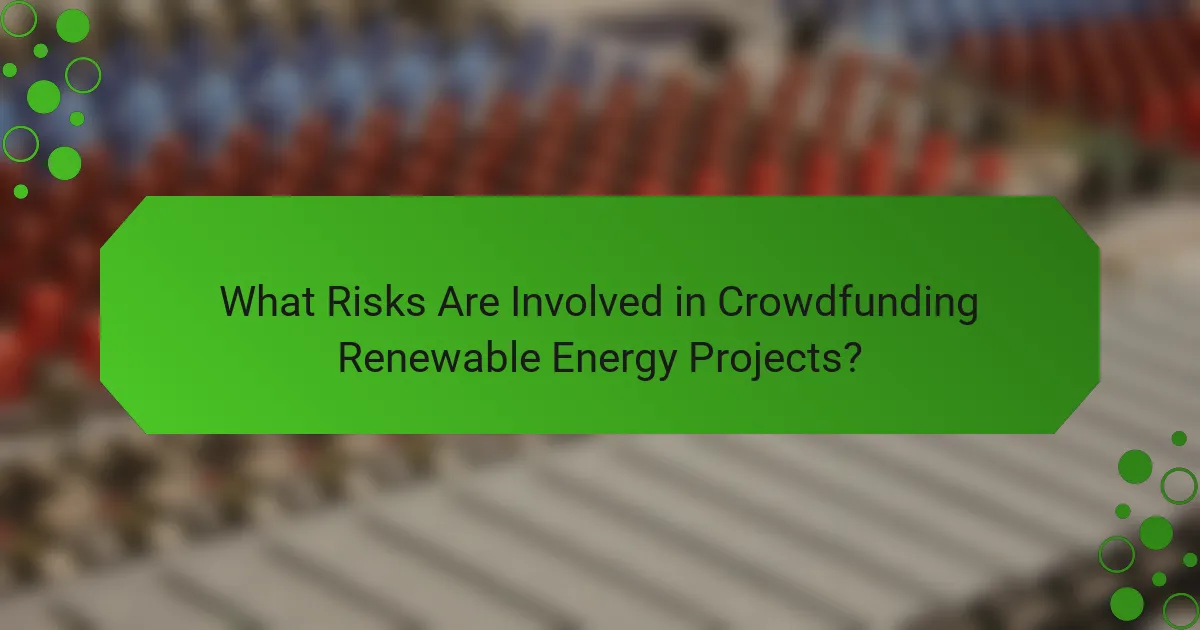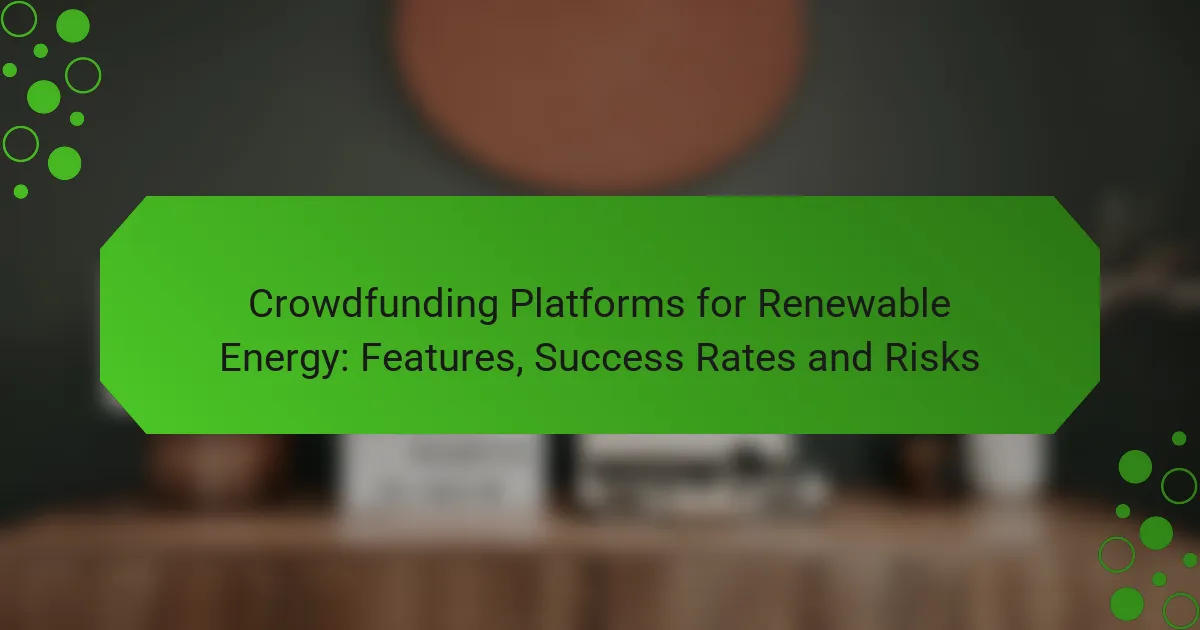Crowdfunding platforms have emerged as vital tools for financing renewable energy projects, each offering distinct features tailored to different needs. Selecting the appropriate platform involves considering usability, transparency, and support, as well as understanding the associated risks and success rates, which can range from 30% to 70%. By evaluating these factors, project creators can enhance their chances of securing the necessary funding for their initiatives.

Which Crowdfunding Platforms Are Best for Renewable Energy?
Several crowdfunding platforms cater specifically to renewable energy projects, each offering unique features and benefits. Choosing the right platform depends on factors like project type, funding goals, and target audience.
Kickstarter
Kickstarter is a popular platform for creative projects, including renewable energy initiatives. It operates on an all-or-nothing funding model, meaning projects must reach their funding goal to receive any money. This approach can motivate backers to contribute, knowing their funds will only be used if the project is fully funded.
When using Kickstarter, ensure your project has a compelling story and clear visuals to attract potential backers. Setting a realistic funding goal and timeline is crucial, as projects typically have a 30-day limit to reach their target.
Indiegogo
Indiegogo offers more flexibility than Kickstarter, allowing both all-or-nothing and flexible funding options. This means that even if a project does not meet its goal, the creator can still keep the funds raised, which can be beneficial for renewable energy projects that may require ongoing support.
Indiegogo also provides a range of tools for project promotion, including marketing resources and analytics. Consider utilizing these features to enhance your campaign’s visibility and reach a broader audience.
GoFundMe
GoFundMe is primarily known for personal fundraising but can be used for renewable energy projects as well. Unlike other platforms, GoFundMe does not require a funding goal, allowing creators to receive contributions at any level. This can be advantageous for community-based renewable energy initiatives.
However, GoFundMe campaigns often rely heavily on social media sharing and personal networks for success. Crafting a strong narrative and engaging potential donors through updates can significantly improve funding outcomes.
Seedrs
Seedrs is an equity crowdfunding platform that allows investors to buy shares in renewable energy startups. This model can attract investors looking for a financial return alongside supporting sustainable initiatives. Projects listed on Seedrs must meet specific regulatory requirements, making it essential to prepare thorough documentation.
Engaging with potential investors through detailed business plans and financial projections is vital. Seedrs also offers a secondary market for shares, providing liquidity options for investors, which can make your project more appealing.
Crowdfunder
Crowdfunder focuses on equity crowdfunding, enabling businesses to raise capital by offering shares to investors. This platform is suitable for renewable energy companies seeking significant funding while providing investors with potential returns. Projects must comply with local regulations, which can vary by country.
To succeed on Crowdfunder, present a solid business model and articulate the potential impact of your renewable energy project. Engaging with investors through updates and transparent communication can help build trust and encourage investment.

What Features Should You Look for in a Crowdfunding Platform?
When selecting a crowdfunding platform for renewable energy projects, focus on features that enhance usability, transparency, and support. Key aspects include the fee structure, user interface, payment options, and the level of campaign support provided.
Fee structure
The fee structure of a crowdfunding platform can significantly impact your project’s financial viability. Look for platforms that clearly outline their fees, which may include a percentage of funds raised, transaction fees, or monthly subscription costs. A typical range for platform fees is between 5% and 10% of the total funds raised.
Consider platforms that offer tiered pricing models, where fees decrease as the amount raised increases. This can be beneficial for larger projects, allowing you to retain more funds for your renewable energy initiative.
User interface
A user-friendly interface is crucial for both project creators and backers. The platform should have an intuitive design that makes it easy to navigate, set up campaigns, and track progress. Look for features like customizable project pages, clear instructions, and mobile compatibility.
Test the platform’s interface by creating a mock campaign. This will help you assess how straightforward the process is and whether the tools provided meet your needs for presenting your renewable energy project effectively.
Payment options
Flexible payment options are essential for attracting a diverse range of backers. Ensure the platform supports various payment methods, including credit cards, bank transfers, and popular digital wallets. This variety can enhance the likelihood of securing funding from different demographics.
Check if the platform allows for international payments, especially if you aim to reach a global audience. Be aware of any currency conversion fees that may apply, as these can affect the total amount received for your project.
Campaign support
Effective campaign support can make a significant difference in your fundraising success. Look for platforms that offer resources such as marketing tools, templates, and access to a community of other project creators. Some platforms may also provide expert advice or coaching to help you refine your campaign strategy.
Consider platforms that offer promotional opportunities, such as featuring your project on their homepage or social media channels. This can increase visibility and attract more backers to your renewable energy initiative.

What Are the Success Rates of Renewable Energy Crowdfunding?
The success rates of renewable energy crowdfunding projects vary widely, typically ranging from 30% to 70%. Factors such as project type, funding goals, and marketing strategies significantly influence these outcomes.
Average success rates
On average, renewable energy crowdfunding campaigns experience success rates between 40% and 60%. Projects that effectively communicate their value proposition and engage with potential backers tend to perform better. For example, solar energy initiatives often see higher success rates compared to less familiar technologies like tidal energy.
Factors influencing success
Several factors impact the success of crowdfunding campaigns in the renewable energy sector. Key elements include the clarity of the project’s objectives, the credibility of the team behind it, and the marketing efforts employed. Additionally, projects that offer attractive incentives or rewards for backers generally attract more funding.
Market trends and public interest in sustainability also play a crucial role. Campaigns launched during periods of heightened awareness about climate change may benefit from increased support.
Case studies
One notable case is a solar farm project in Germany that successfully raised over €1 million through crowdfunding, achieving a 75% success rate. The project utilized social media effectively to engage the community and highlight the environmental benefits.
Conversely, a wind energy project in the UK struggled to meet its funding goal, reaching only 30% of its target. The campaign lacked clear communication about the project’s benefits and failed to generate sufficient public interest.

What Risks Are Involved in Crowdfunding Renewable Energy Projects?
Crowdfunding renewable energy projects carries several risks that potential investors should consider. These risks can affect the financial viability, regulatory compliance, and market acceptance of the projects.
Financial risks
Financial risks in crowdfunding renewable energy projects include the potential for project delays, cost overruns, and lower-than-expected returns. Investors might face the possibility of losing their entire investment if the project fails to generate revenue or if it does not reach its funding goal.
It’s crucial to evaluate the financial projections of a project carefully. Look for transparency in cost estimates and timelines, and consider diversifying investments across multiple projects to mitigate individual project risks.
Regulatory risks
Regulatory risks involve changes in laws and policies that can impact renewable energy projects. These can include shifts in government incentives, tax credits, or environmental regulations that may affect project feasibility and profitability.
Investors should stay informed about local and national regulations governing renewable energy. Understanding the legal landscape can help identify potential risks and ensure compliance with necessary permits and standards.
Market risks
Market risks pertain to fluctuations in energy prices and demand for renewable energy. If energy prices drop significantly, the financial returns on renewable projects may diminish, making them less attractive to investors.
To navigate market risks, consider investing in projects with long-term power purchase agreements (PPAs) that guarantee a fixed price for energy over a specified period. This can provide a buffer against market volatility and enhance the project’s stability.
